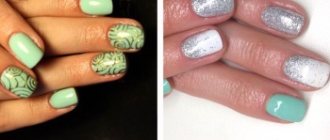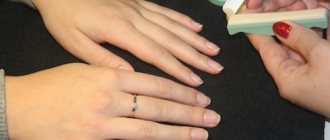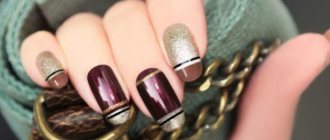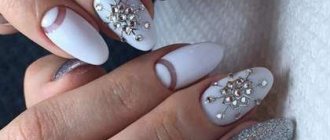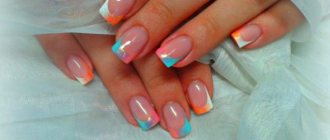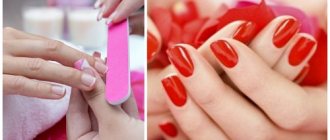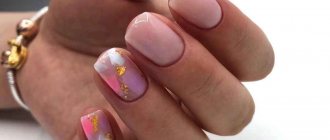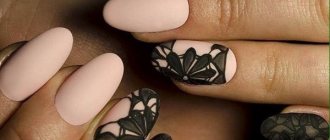Rating: 5/5 (1)
Green tea, rice flour, a touch of silk, pearl powder. And these are just a few names from the list of ingredients that Japanese women use for personal care. The well-groomed appearance of Japanese women is the result of a daily multi-stage ritual of hydration, nutrition and light massage . In any cosmetic procedure, Eastern women try not only to decorate themselves, but also to decorate the world around them. They actively use light touches and aromatic oils, including in manicure.
Features of Japanese manicure
Features also come from Japanese culture, where this technique has been honed over centuries. Let's look at the main differences and advantages of a beautiful Japanese manicure.
- All components are natural - suede, pearl powder, algae extracts, beeswax.
- The technique of execution is only the hands and skill of a master . In the classic version, the master should not touch the client’s hands with synthetic or iron objects.
- The procedure is safe for everyone , including pregnant women.
- The sealing technique improves the quality of nails even with not the best natural characteristics.
- The nail breathes and at the same time looks beautiful without additional decoration.
- The result is visible immediately , but recovery continues up to 1 month after the procedure.
Types of Japanese manicure
Therapeutic manicure involves a more thorough diagnosis of the condition of the client’s nails. Next, the master selects individual medications for treatment and recovery. For a good result, you must repeat the procedure at least 3 times . In addition, the client must independently rub the medicated paste into the nail plate according to the recommendations. Therapeutic manicure is performed by the most experienced and trained professionals.
Cosmetic manicure is carried out for prevention, to strengthen nails without any problems. For example, after removing extended nails that have become thinner due to diet and weight loss. And just when living in a big city. For cosmetic purposes, manicure can also be done at home.
Spa manicure is the most pleasant and relaxing. Masks, creams, aromatic additives create the right atmosphere for relaxation. Care is carried out not only for nails, but also for the skin of the hands. Silk bags with herbs are heated, after which the master gently massages your hands. At the same time, the client receives an aromatherapy session.
The general rule of all types is that manicure is carried out without fuss, in a unique manner, with soft touches and pats. You can combine all 3 types.
Fashionable ideas for Japanese manicure
Japanese manicure Masura
The Masura company has been working on the problem of restoring and strengthening nails for several decades. Masura values its reputation by providing customers with high-tech, natural materials. The company opens training centers in many countries, where professionals undergo multi-stage training. Therefore, a real Japanese Masura manicure cannot be cheap.
Japanese style manicure is a long and voluminous procedure. The wizard selects the components that are suitable for you from more than twenty names. And the names themselves, just listen: wooden stick “Tachibana”, polishing block “Samurai”, bath with “Royal pearls” and mineral serum “Nail Breath”. Sounds peaceful, doesn't it?
Japanese manicure P Shine
Permanent gloss or P Shine (Permanent Shine) indicates the final result - sealing the nail. Nails breathe and are restored as a result of saturation with microelements. The protective coating is not washed off with water and lasts up to 3 weeks.
Japanese Pi Shine manicure is first performed with diamond files. After this, the cuticle is treated and removed with special serums and the nail itself is sealed, after which the master polishes the nail with pearl powder. This gentle procedure supports the physiology of the nail and cares for the hands. The effect of this procedure lasts up to 30 days.
Japanese eco-manicure
The eco prefix itself is very popular today and involves working with natural products. Japanese manicure with natural ingredients achieves an effect in which nails are restored even when applying and removing nail polish . The ideal result of an eco-manicure is to give your nails a pearly shine. The Japanese generally love and respect everything related to pearls. Shining from within, like a pearl in a shell, is the most valuable thing in the beauty industry.
Even colored nail coatings are not bright, but soft, pastel. And what poetic names: what the forget-me-not whispers about, emerald moss, green bamboo.
Japanese therapeutic manicure
Healing is the general name for Japanese manicure, because it heals not only nails, but also the soul. This is done not for the sake of design, but to restore internal harmony. There can be up to 10 stages in one procedure, it all depends on the degree of damage to the nail . Even the antiseptic components are exclusively natural - tea tree, mint.
Japanese women respect oil structures and algae extracts and actively use them in face and hand care. And at the same time, they don’t use many components. Therapeutic procedures are only the most proven - massage and steaming.
Japanese spa manicure
The beautiful name Kaori Spa is a description of the aroma effect of a spa treatment. Kaori (soft, affectionate) – the smell of early morning, an invigorating, rich and subtle aroma. Spa manicure is a peeling massage, exfoliating masks with palmarosa extract, hand and nail cream based on jasmine oil.
Types of Japanese manicure and techniques for its implementation
The main trends in Japanese manicure are: Japanese manicure using the Masura technique and Japanese manicure using the P.Shine technique. Masura uses certain products and materials of the same brand to carry out this technology. P.Shine adheres to the same principle. What is the difference between these healing techniques? At first glance, they do not differ much from each other; the approach of P.Shine manicure and Masura manicure is similar. However, the products they use in their procedure and, accordingly, the price vary. If in Masura the main components are Ni mineral paste, XOH powder, cuticle products based on Jojoba oil, etc., then for P.Shine manicure they use wax and diatomaceous clay.
The initial stage of Japanese manicure is diagnostics of the nail plates. This check is important and makes a huge difference to the health of your hands. It is after the analysis that the master will select and perform the procedure necessary for you. After this, our technologies diverge, as each has its own individual approach.
Masura
Japanese manicure using the Masura technique is performed according to the following scheme:
- Nails are degreased before performing procedures.
- The cuticle is treated with emollients for treatment.
- Hands are toned in a hot bath with Yumi stones.
- A European manicure is performed; the cuticle is not cut, but pushed back.
- The liquid with minerals and seaweed extract softens the skin.
- Healing Ni paste is rubbed into the nail plates and polished with a special SHITA block made from genuine calfskin.
- Thanks to Non wax polishing powder, a kind of protective shell is created.
- The surface of the nail plates is covered with medicinal serum.
- A wonderful massage is performed using heated Assui bags.
P.Shine
Manicure using the P.Shine technique is carried out in the following sequence:
The first stage is permanent glossing:
- Nail plates are restored using a special oil, which requires up to 3 weeks of application.
- The surface of the nail is cleaned and the protective layer is carefully removed.
- A special paste is applied with a suede buff.
- Powder produces gloss.
Then you can proceed to your regular manicure. The completed glossing serves as an ideal base for applying varnish.
The second stage of manicure is an innovative SPA, three in one:
- With the help of mineral granules and a special solution, dead skin cells are gently exfoliated.
- Next, restoration from the inside is applied using silicon.
- Nails and hand skin are moisturized and nourished with silk proteins, trehalose and royal jelly.
The third stage is immunity for nails:
- Due to oxygen saturation, nutrition and regeneration occur.
- Restoring fat deficiency in the nail plate.
- Gives a healthy and natural look to your nails.
It turns out that Japanese manicure is a universal set of excellent products for the best appearance of your nails. And judging by the reviews, it brings pleasure even from the very execution.
How to do Japanese manicure at home
It is difficult to carry out the entire complex of procedures at home, since it consists of many components. You can do a basic procedure for strengthening and restoring your nails at home.
There are drugs on sale from the companies Masura and Pi Shine. A set for Japanese manicure can be purchased online or in specialized salons. You can also purchase other components there. The set is enough for 10 repetitions, the effect lasts 4-5 days.
The set includes: wooden chichibana sticks, polishing powder, mineral paste, polishing block with a suede layer.
Sequencing:
- Treat your hands with an antiseptic and use a nail file to shape the nail.
- Soften nails and cuticles in a bath of salt, push back the cuticles with a wooden stick.
- Gently rub the mineral paste into the nail plate with the suede side of the nail file.
- Polish your nails with powder. Eventually We get shiny and well-groomed nails without decorative varnish.
Reviews of beautiful Japanese manicure
Natalya, 31 years old
My nails have never pleased me, but I’ve never even heard of such a sophisticated procedure. Recently, my friends presented me with a gift certificate to a new salon. And there I tried Japanese manicure for the first time. To say that I am surprised is to say nothing. The procedure is radically different from anything I have tried. Including the result.
Japanese manicurist: Now specialized salons are opening in many cities. As a rule, they are designed in the appropriate theme, but you should not pay much attention to the surroundings. The main thing is certification and training of the master. The full procedure is very labor-intensive and cannot be cheap. How Japanese manicure transforms nails can be seen in the photo (before and after).
Irina, 44 years old
My husband and I are planning a pregnancy. I gave up many habits, including nail extensions. In addition, I know that during pregnancy the condition of the nails worsens. For prevention, I signed up for several sessions of therapeutic Japanese manicure. The result exceeded expectations. A very relaxing procedure.
Japanese manicurist: It is during this period of a woman’s life that she should not only give her nails a rest, but also invest effort and money in their restoration. The procedure is absolutely safe for both the pregnant woman and the unborn child. So, good luck to you.
Svetlana, 25 years old
By the way, I have heard the most contradictory reviews about such a procedure as Japanese manicure. From enthusiastic gasps to accusations of extorting money from clients. The sites only offer price lists and little information about the usefulness of this procedure.
Japanese manicurist: I think you shouldn’t draw conclusions based on someone else’s subjective opinion, as well as rush and overpay for gadgets you don’t need. Choose a salon carefully, ask about certificates. Talk to the master in person. If in doubt, buy a set for home use. Remember that the opinion of a salon employee is not the ultimate truth. There is also your common sense.
Japanese manicure: execution technology
Date posted : February 23, 2021 Japanese manicure and pedicure is a unique oriental nail care procedure that allows you to completely restore weakened and damaged nails.
After several sessions of Japanese care, nails become hard, elastic and smooth and acquire a healthy pink tint and natural shine. This type of manicure is similar to the now popular SPA treatment, however, it also has a number of features. First of all, the result is visible almost immediately. Within two weeks, many nail problems are solved. Japanese manicure is not just removing the cuticle and polishing the nails, but also a unique method of caring for the nail plate. It differs from European and American methods in that only natural materials and preparations are used, such as: essential oils, algae extracts, bamboo, red tea, natural jojoba oil, beeswax and pearl chips. This is a whole complex of preparations with the help of which a professional master turns his client’s nails into a real work of art. The nails acquire a natural shine, the nail plate becomes firm and elastic, the procedure helps create a gloss on the surface and, as a result, the client’s nails look extremely healthy. The components of the procedure contain substances such as glycerin, panthenol and lanolin - excellent moisturizers, silicone and zinc - elements necessary for optimal growth of healthy nails, vitamins A, E, H in combination with provitamin B5 - known as necessary substances for the regeneration of the nail plate and the prevention of brittleness nail
Thus, the Japanese manicure and pedicure procedure is not only aesthetic nail care, but also a whole range of restorative and therapeutic procedures necessary for nails after the extension procedure, in case of allergic reactions to organic liquids, such as nail polish, as well as supportive care for throughout the year.
Set for Japanese manicure photo
Recommendations for Japanese manicure and pedicure:
- Japanese manicure and pedicure are recommended to be done every two weeks, since during this time the nails absorb all the nutrients from the paste.
- Japanese manicure and pedicure can be considered as a separate procedure or as a complement to other nail care options.
- The minimum recommended course of treatment is 8-10 procedures.
- The duration of the procedure is 60 minutes.
To carry out the Japanese manicure procedure, the entire complex is used, which is more than twenty different products from the Japanese SPA line Masura. The basis of all products in Japanese manicure is a large number of natural ingredients.
The main secret of the procedure lies in a special paste, which is unique in its biological effects.
Using a Kichin polishing block made from genuine calfskin, the master rubs mineral paste onto the surface of the nails. The base of the paste consists of pearl chips, beeswax, ocean algae from the Sea of Japan and specially selected minerals. It quickly penetrates the nail matrix, stimulating cells to regenerate.
The paste, saturated with ceramides, zinc and calcium, cements microcracks, strengthens the keratin chain in the nail structure, nourishes and moisturizes the nail plate. And pearl powder, which contains all the necessary microelements, being the most fashionable charm of Japanese manicure, gives nails whiteness, strength and a smooth surface.
After rubbing the paste into the nail plate, polishing powder with Hon silicon is applied, which secures the resulting smoothness of the nails and creates a protective film, sealing the nail with its natural composition. Thus, a strong shell is created - a case for natural nails, which helps retain the necessary moisture and protects the nail plate from external influences of an aggressive environment.
Japanese manicure technology
The composition of some caring substances is selected individually, so before purchasing them, consult a consultant. Which will help you choose everything you need.
The technology itself used for Japanese manicure looks like this:
- Japanese p shine eco manicure requires preparation: first, a softening hand bath is made, and the skin is treated with a gel scrub.
- Moisturizing: A cleansing and degreasing agent made from rice milk and proteins is applied to hands and nails. A special serum made from cucumber extract is applied to the nail plates
- Strengthening: A serum is applied to the nails to stimulate growth and strengthen the nail. It contains a whole cocktail of useful substances: pearl powder, proteins, calcium, ceramides. Nails are treated with ceramide-ginseng coating. Because of this, Japanese p shine eco manicure has a healing effect.
- Cuticle care: use an orange stick to push back the cuticle, previously softened with a product made from plant and mineral extracts.
- Caring for the plates: the nails are covered with a paste, which is rubbed in with a polishing block. Then cover with powder and polish again.
- Hand massage, which is done in a salon with heated bags filled with herbs and mineral salts. In order to do Japanese p shine eco manicure at home, you can make them yourself: take pieces of linen, fill them with crushed dried herbs. You can add coarse sea salt.
First, you should purchase all the necessary tools. This approach will save money, teach you the basics of nail design and proper hand care. You will be able to regularly perform wellness procedures without resorting to the expensive services of specialists, and will also save time on trips to the salon and back.
The standard set for such a manicure includes:
- orange tree sticks (titiban), which are designed for working with cuticles and applying medications;
- polishing block made of calf leather;
- polishing powder for polishing the nail plate to obtain a mirror-shiny and perfectly smooth surface;
- block file based on non-artificial suede;
- mineral paste for filling and sealing microcracks on nails.
The latter consists of natural wax, which is why even very exfoliated plates acquire smoothness, evenness and natural shine. The paste includes peptides of marine origin, pearl crumbs, and creatine, which well moisturize and nourish tissues.
But in addition to this basic kit, you will also need gels and serums. They are necessary for preparing nails and during the procedure. The specific composition is selected purely personally, so before purchasing, consult a specialist in detail.
Japanese manicure before and after photos
This procedure takes about 60 minutes. But if necessary, you can stretch it out to fully enjoy the process, to do everything thoroughly, thoughtfully and leisurely.
After gaining experience, naturally, the process of applying Japanese manicure will go much faster with the same high result, so that your nails remain well-groomed and flawless for longer. The optimal frequency of procedures is once every two weeks, although the effect usually lasts up to three weeks, despite the use of varnishes and liquids to remove them. Basically, Japanese manicure is individual, since it takes into account the specific condition of the nails and skin of the hands, but classically includes several stages.
- We evaluate the condition of the hands and make a bath (preferably herbal). It will soften the periungual area. We treat the skin with a gel scrub so that the cuticle becomes as pliable as possible and moves easily.
- Let's move on to hydration. To do this, apply a protein-based cleansing and degreasing agent with the addition of rice milk. We cover the nail plates with a special mixture of cucumber extract.
- Then we proceed to care for the cuticle, for which we gently move it with an orange stick, which we first moisten in a substance made from a mixture of minerals and plant extract.
- Let's start strengthening our nails. Take a serum with a growth stimulation effect and apply it to your fingers. It consists of a whole set of useful components: keratin, calcium, protein, pearl powder.
- We move on to treating the nail plates with a ceramido-ginseng coating, which has a healing effect.
- We begin to apply a disinfectant composition, the main ingredients of which are beeswax and seaweed from the Sea of Japan.
- Then we seal the nail plates. To do this, cover with mineral paste, rubbing it into the surface with a polishing block. Sprinkle with powder and polish again. The result is a kind of shell.
- We replace the salon massage of the hands with heated bags with our own invention, having prepared it in advance. That is, we make our own bags from pieces of linen fabric. Fill them with dried herbs and coarse sea salt. While the procedure is underway, keep the bags warm and use them as needed instead of massage.
Combination of Japanese manicure with other types of design solutions
Japanese manicure maintains naturalness. After the procedure, your nails look so good that you don’t want to apply clear polish. Healthy nails go well with any decoration , and are such in themselves.
But it just so happens that traditionally a woman should wear her nails painted at special events. A high-quality procedure does not lose its properties after applying and removing the varnish . If the exit regulations require design, you can paint your nails in Japanese style. But it is wrong to talk about Japanese manicure as a specific design. The procedure itself is not cheap, so no additional confirmation of your eligibility is needed.
Are you familiar with this beautiful ritual called Japanese manicure? Do you think it's right for us? Share your opinion, we will be grateful to you.
Ideas for Stunning Japanese Manicures
Many fashionistas, when undergoing a restorative Japanese procedure, believe that any design is contraindicated. But this is far from true! In Japan, women love to express their individuality and decorate their nails through their manicure. In order to continue the Japanese theme with us, you can choose the appropriate design with Japanese motifs. A recent trend is a technique in which each nail is decorated in its own way. On one hand you can see a plain coating and rhinestones, geometric shapes and hieroglyphs, flowers and various patterns. If you decide to completely immerse yourself in Japanese style, use eco-varnish.
